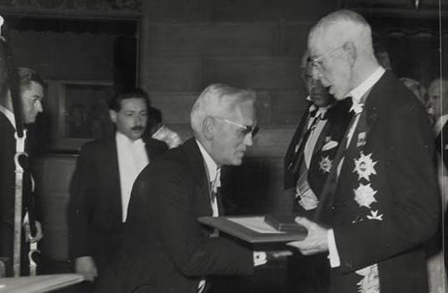Alexander Flemming in his Laboratory at St. Mary's Hospital, London.
On September 28, 1924 Dr. Alexander Fleming, a Scottish physician and researcher, stumbled on one of the most significant accidental discoveries in scientific history—and was smart enough to understand what it meant.
Fleming was born to middling farmers on August 6, 1881 at Lochfield, a farm near Darvel in Ayrshire, Scotland. Although he got excellent marks in school, and small scholarships allowed him to enroll at the Royal Polytechnic Institution for studies in biology, he was unable to continue his education and worked as a shipping clerk for some years before a small inheritance allowed him to enroll in medical school at St Mary’s Hospital in Paddington, London. He graduated with honors in 1906 qualified as a surgeon.
Instead of going into practice as a surgeon, however, Fleming was encouraged to join the research department at St Mary’s, as assistant bacteriologist to Sir Almroth Wright, a pioneer in vaccine therapy and immunology. He earned an M.B. degree and then a B.Sc. with Gold Medal in 1908. He stayed at St. Mary’s as a lecturer in biology until the War broke out in 1914.
As a captain in the Royal Army Medical Corps, Fleming served with distinction and was cited for bravery in advanced field hospitals on the Western Front. At War’s end he returned to St. Mary’s determined to find antibacterial agents.
Flemming's contaminated culture--a blob of mold, left, killed the bacteria near it.
That day in 1924 the 43 year old doctor had returned to his basement laboratory at St Mary’s after a long holiday with his family in Scotland. He had left a pile of petri dishes containing bacteria samples on a laboratory bench having forgotten to refrigerate them. He was going to discard the ruined samples when he noticed the bacteria in one dish were being killed by an invading grey/green fungus. Fleming, who had been actively looking for anti-bacterial agents since his World War I time service in France where he saw many men lose limbs or their lives to septicemia from infected wounds, understood that something in that fungus could kill bacteria.
Fleming first called the substance that killed the bacteria simply mold juice. After some difficulty, he identified the mold as a member of the Penicillium genus and named the substance penicillin when he published his findings in the British Journal of Experimental Pathology in 1929.
He found penicillin very difficult to produce and despaired that it could be produced in sufficient quantities to become important in treating infections. He did recognize that if penicillin were used in insufficient concentrations or over too short a period of time, that the bacteria evolved to become resistant to the serum. He also identified many bacterial organisms against which it was effective, including those that caused scarlet fever, pneumonia, meningitis, diphtheria, and gonorrhea but not infections like typhoid fever. Fleming therefore cautioned that if used, it must only be applied to those illnesses for which it was proven effective and in sufficient strength of and then only in sufficiently high doses over an extended period of time in order to prevent the spread of drug-resistant bacterial strains.
As Fleming continued his research into the 1930’s he became further discouraged. He was applying penicillin primarily as a topical application to open wounds. He began to fear that the serum would not live long enough in the body to become effective against deep infections. Later, he began to experience better results, but without a method of producing the anti-biotic in mass quantity, he abandoned his research and turned to trying to find other agents.
Fleming (center) receiving the Nobel prize from King Gustaf V of Sweden in 1945 as Ernst Chain and Howard Florey wait their turn.
In 1939 German born Ernst Boris Chain and Howard Florey at Oxford University took up where Fleming had left off. They discovered penicillin’s chemical composition and accurately predicted the physical structure of its molecule. With a new war, both the British and U.S. governments poured money into research which led to mass production techniques. By the time of the D-Day invasion enough penicillin was available to treat all of the Allied injured. By the end of the war it was available worldwide.
In honor of their work Fleming, Chain, and Florey shared the 1945 Nobel Prize in Medicine.
Penicillin slashed death from infected wounds and battled venereal disease in World War II.
More research has developed other penicillin-like drugs. By mid-century the infectious diseases that had been some of humanities most persistent killers, were controllable.
Fleming died, full of honors, on March 11, 1955 in London at the age of 73. He did not live to see his often expressed dire warnings about the emergence of drug resistant bacteria come fully to reality. Years of routine over-prescription of penicillin and related antibiotics have led to the development of resistant superbugs which could possibly threaten new, widespread epidemics.




No comments:
Post a Comment